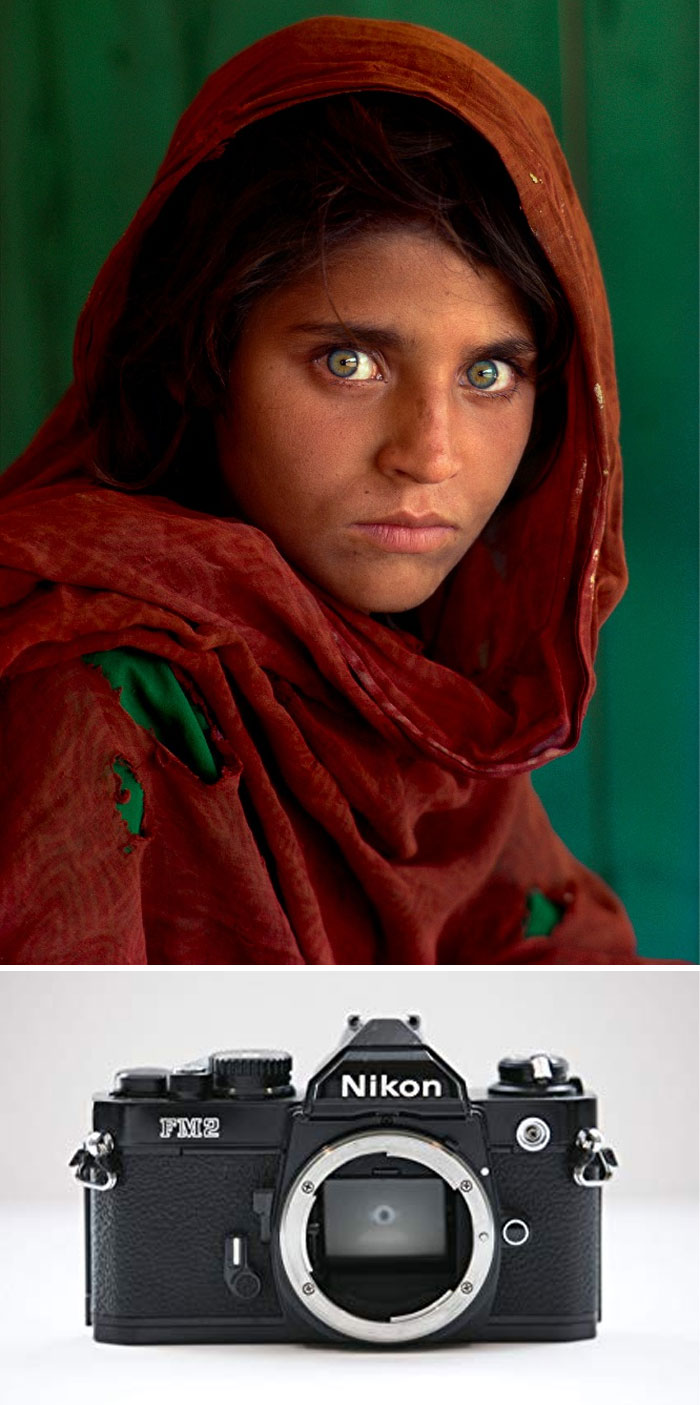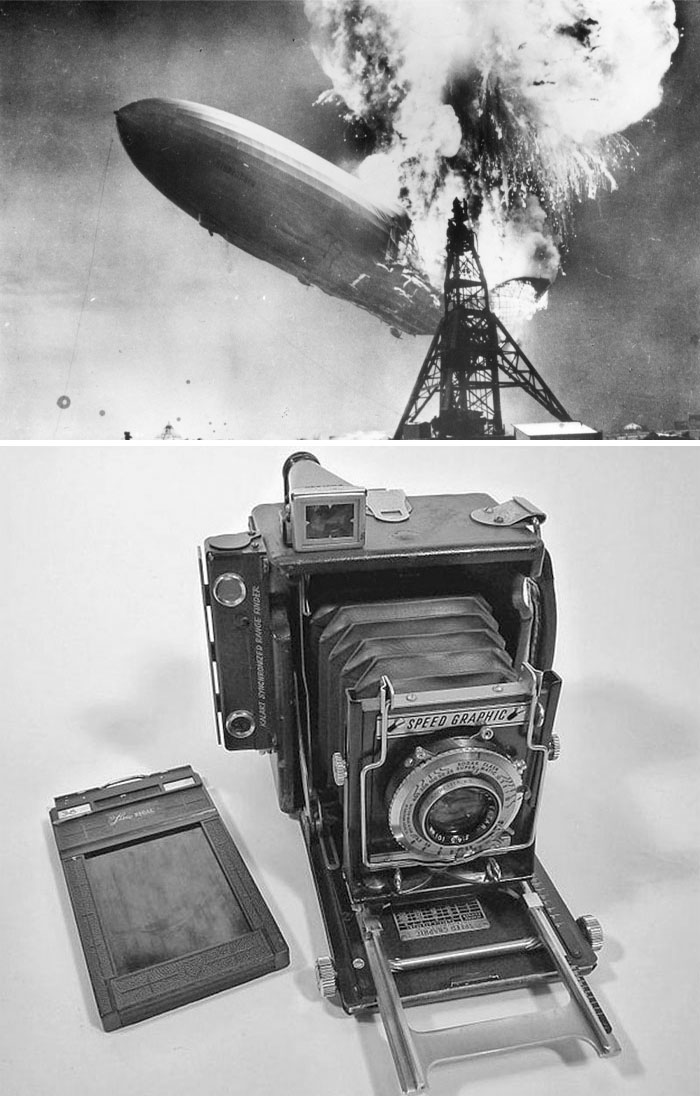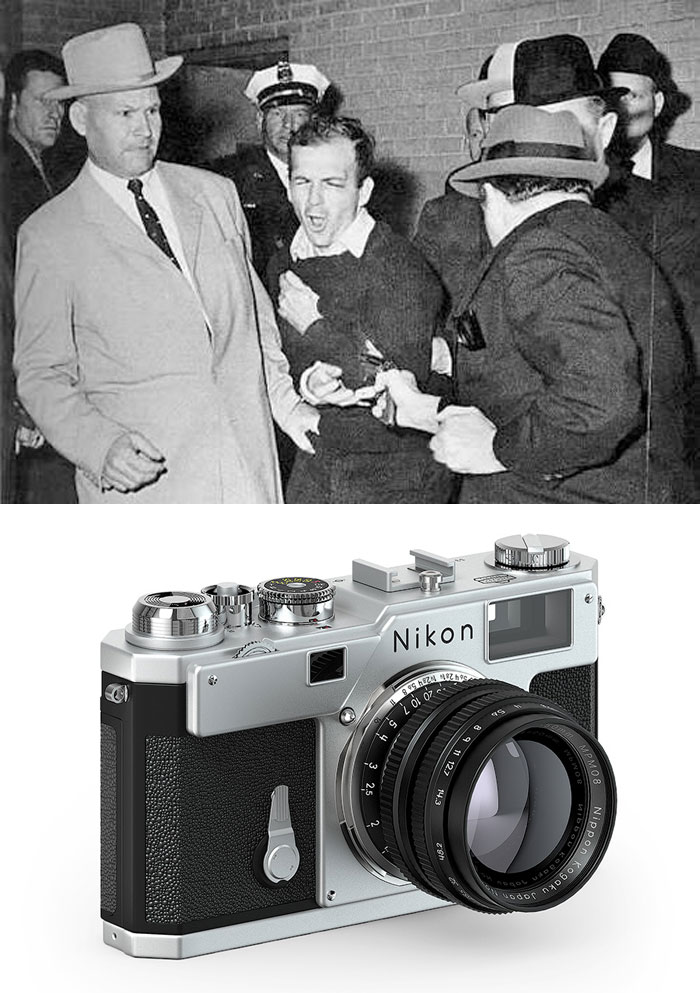
20 Of The Most Iconic Photographs And The Cameras That Captured Them
They say a picture is worth a thousand words. Some pictures, however, are worth at least a million. I’m talking about the iconic pictures that nearly everyone recognizes and that will forever be etched into our shared history. Even though these historical photos might be known by all, far from everyone knows about the superstar photographers who took them. Even less know about the film photography cameras they used to capture history in the making. Buckle up, amigos, you’re about to become photography buffs!
This post may include affiliate links.
"Earthrise" By William Anders, 1968 / Modified Hasselblad 500 El
Earthrise is a photograph of Earth and some of the Moon's surface that was taken from lunar orbit by astronaut William Anders during the Apollo 8 mission. The photograph was taken from lunar orbit on December 24, 1968, 16:00 UTC, with a highly modified Hasselblad 500 EL with an electric drive. The camera had a simple sighting ring rather than the standard reflex viewfinder and was loaded with a 70 mm film magazine containing custom Ektachrome film developed by Kodak. Immediately prior, Anders had been photographing the lunar surface with a 250 mm lens; the lens was subsequently used for the Earthrise images.
Yes, but, this picture was never taken either - because we never went to the moon - remember? We are living in The Matrix, nothing really happened! Or maybe the picture was taken when the Moon was on top, for a change! :-)
One of the most iconic historical photos is, without a doubt, The Burning Monk. We’ve all seen this photo in school books, on the news, and in most-famous photo lists. The monk’s name was Thích Quảng Đức. He self-immolated in Saigon on June 11, 1963, to protest the South Vietnamese government's persecution of Buddhists. The person who captured this selfless sacrifice for the greater good was photographer, Malcolm Browne. He passed away in 2012 but his iconic photo legacy lives on.
"Tank Man" By Jeff Widener, 1989 / Nikon Fe2
Tank Man (also known as the Unknown Protester or Unknown Rebel) is the nickname of an unidentified Chinese man who stood in front of a column of tanks leaving Tiananmen Square on June 5, 1989, the morning after the Chinese military had suppressed the Tiananmen Square protests by force. As the lead tank maneuvered to pass by the man, he repeatedly shifted his position in order to obstruct the tank's attempted path around him. The incident was filmed and smuggled out to a worldwide audience.
“I was thinking only about the fact it was a self-illuminated subject that required an exposure of about, oh say, f10 or whatever it was, I don't really remember. I was using a cheap Japanese camera by the name of Petri,” Browne told Time in an interview about that historic day. “I was very familiar with it, but I wanted to make sure that I not only got the settings right on the camera each time and focused it properly, but that also, I was reloading fast enough to keep up with the action. I took about ten rolls of film because I was shooting constantly.”
Lyle Owerko, 2001 / Fuji 645zi
Filmmaker and photographer Lyle Owerko was in NY during the fateful day back in 2001. So it happened that he had his camera ready and when the tragedy struck, he took some of the photos that soon would become historical and end up as the cover photo of TIME.
Another vintage photo I’m sure you’re all intimately familiar with is the famous Kiss in Times Square. Alfred Eisenstaedt captured a sailor kissing a random woman on Victory Over Japan Day, August 14, 1945. This photo captured America’s heart. Eisenstaedt used a Leica IIIa camera to capture the passionate embrace. The camera eventually sold for $147,000 at auction!
"Burning Monk" By Malcolm Browne, 1963 / Petri
Thích Quảng Đức was a Vietnamese Mahayana Buddhist monk who burned himself to death at a busy Saigon road intersection on 11 June, 1963. He was protesting the persecution of Buddhists by the South Vietnamese government.
Malcolm Browne used a Japanese-made Petri camera to take this iconic photo. Browne admitted in an old interview that he couldn’t remember what exposure he used.
Some people still use Leica camera models today, however, it’s a pretty expensive hobby to have. Vintage Leica III cameras such as the one used by Yevgeny Khaldei cost upwards of $1,000. However, for those of you who want a more modern camera, Leica is still innovating and making new products. I personally had the pleasure of using a Leica M4 model, just like the one Eddie Adams used, a few times during photography class in high school. Not going to lie to you, it was awesome and felt very natural to use.
"Afghan Girl" By Steve McCurry, 1984 / Nikon Fm2
Afghan Girl is a 1984 photographic portrait by journalist Steve McCurry. It appeared on the June 1985 cover of National Geographic. The identity of the photo's subject was not initially known but in early 2002, she was identified as Sharbat Gula. She was an Afghan child who was living in the Nasir Bagh refugee camp in Pakistan during the time of the Soviet occupation of Afghanistan when she was photographed.
You can still get secondhand Speed Graphic cameras, like the ones Yasushi Nago and Sam Shere used, for one to several hundred dollars, depending on where you look.
If you’ve ever wondered who made the first commercial camera, then wonder no more! It was George Eastman, founder of Kodak. He built the camera in 1888. However, it was the size of a microwave. By 1900, Eastman released the Kodak Brownie, a simple and cheap camera. An improved model was made just a year later.
"The Hindenburg Disaster" By Sam Shere, 1937 / Speed Graphic
The Hindenburg disaster occurred on May 6, 1937, in Manchester Township, New Jersey, United States. The German passenger airship LZ 129 Hindenburg caught fire and was destroyed during its attempt to dock . On board were 97 people; there were 36 fatalities.
The camera shown was not available in 1937. This one was made after July 1945. I'm certain the one that took the photograph was a 4x5 model. This one is a 2x3.
Around 1930, world-class photographers started using 35mm cameras so they could take pictures of events as they happened instead of making staged portraits. Around the same time, Polaroid created the iconic camera that developed pictures inside itself. The late 1970s saw the advent of “point and shoot” cameras, while the first digital camera good enough to be used by professionals came in 1991, again thanks to Kodak. Eventually, cameras became so tiny, you could incorporate them into phones. Sharp Corporation made the first camera phone (the model J-SH04) and it was released in 2000.
"Migrant Mother" By Dorothea Lange, 1936 / Graflex Super D
On March 6, 1936, after picking beets in the Imperial Valley, Florence Owens Thompson and her family were traveling on US Highway 101 towards Watsonville, when the car's timing chain snapped and they coasted to a stop just inside a pea-pickers' camp on Nipomo Mesa. They were shocked to find so many people camping there—as many as 2,500 to 3,500. A notice had been sent out for pickers, but the crops had been destroyed by freezing rain, leaving them without work or pay. While Jim Hill, her partner, and two of Thompson's sons went into town to get the car's damaged radiator repaired, she and some of the children set up a temporary camp. As Thompson waited, photographer Dorothea Lange, working for the Resettlement Administration, drove up and started taking photos of Florence and her family.
"Fire Escape Collapse" By Stanley Forman, 1975 / Nikon F
The photograph shows 19-year-old Diana Bryant and her 2-year-old goddaughter Tiare Jones falling from the collapsed fire escape of a burning apartment building on Marlborough Street in Boston on July 22, 1975. The fire escape at the fifth floor collapsed as a turntable ladder on a fire truck was being extended to pick up the two at the height of approximately 50 feet.
The tillerman of the first fire engine to arrive at the scene, Robert O'Neill, asked 19-year-old Bryant to lift her 2-year-old goddaughter Jones to him on the roof, but Bryant was unable to do so and O'Neill jumped down to help before the ladder could reach them. O'Neill had one arm around the older girl and one hand on a rung of the ladder when the fire escape collapsed. O'Neil managed to hang by one hand and was rescued, but Bryant and Jones fell approximately 50 feet (15 meters) Bryant sustained multiple head and body injuries and died hours later. Jones survived the fall as she had landed on Bryant's body, softening the impact.[2] A helicopter pilot, Joe Green, who provided traffic reports and landed on a nearby roof, reportedly offered to pick up Bryant and Jones, but got no response from the firefighter.[4] (source: wikipedia)
"D-Day" By Robert Capa, 1944 / Contax Ii
This photo is part of a series known as the Magnificent Eleven, a group of photos of D-Day taken by war photographer Robert Capa. Capa was with one of the earliest waves of troops landing on the American invasion beach, Omaha Beach. While under fire, Capa took 106 pictures, all but eleven of which were destroyed in a processing accident in the Life magazine photo lab in London. The pictures have been widely celebrated, and Steven Spielberg is said to have been inspired by them when filming Saving Private Ryan.
Abbey Road Album Cover By Iain Macmillan, 1969 / Hasselblad
On 9 November, 1966, John Lennon met Yoko Ono at the Indica Gallery and later on, she introduced him to Iain Macmillan. In 1969, John invited him to photograph the Abbey Road cover. The Beatles recorded most of their music at the EMI Studios on Abbey Road, St John's Wood, London. They decided to name their last album after the road. Later, EMI changed the name of the studio to the Abbey Road Studios.
Macmillan took the legendary Abbey Road photo using a Hasselblad camera with a 50mm wide-angle lens, aperture f22, at 1/500 seconds.
"The Terror Of War" By Nick Ut, 1972 / Leica M3
Huỳnh Công Út, known professionally as Nick Ut, is a Vietnamese American photographer. His best-known photo features a naked 9-year-old girl, Phan Thị Kim Phúc, running towards the camera from a South Vietnamese napalm strike that mistakenly hit Trảng Bàng village instead of nearby North Vietnamese troops. The photo was taken on June 8, 1972.
Saw a documentary about that photo, and those involved. They interviewed the US soldiers that dropped the Napalm that burned that girl, and the ongoing guilt & PTSD they experienced. They found the girl, now happily married, and emigrated to a new country (USA or Canada... I can't remember). She asked to meet the soldiers, because *she* wanted to tell them that she was well, happy, and held no grudges. The absolute heartbreak & relief in the eyes of these good 'ol boys, when they heard those words from her. Humans can be both horrendous, and full of grace. We are such complex creatures. If only we would remember the lessons, and stop repeating such history. <3
"Raising The Flag On Iwo Jima" By Joe Rosenthal, 1945 / Speed Graphic
This is an iconic photograph taken by Joe Rosenthal on February 23, 1945, which depicts six United States Marines raising a US flag atop Mount Suribachi during the Battle of Iwo Jima in World War II.
Three Marines in the photograph, Sergeant Michael Strank, Corporal Harlon Block, and Private First Class Franklin Sousley were killed in action over the next few days. The other three surviving flag-raisers in the photograph were Corporals (then Private First Class) Rene Gagnon, Ira Hayes, and Harold Schultz.
This was the second photo...in the first one..a nearby commander decided the American Flag was not big enough and made them do it again.
"Invasion 68: Prague", By Josef Koudelka, 1968 / Exacta Varex
Josef Koudelka had returned from a project photographing gypsies in Romania just two days before the Soviet invasion of Czechoslovakia in August 1968. He witnessed and recorded the military forces of the Warsaw Pact as they invaded Prague and crushed reforms of the so-called Prague Spring. Koudelka's negatives were smuggled out of Prague to the Magnum agency, and published anonymously in The Sunday Times Magazine under the initials P. P. (Prague Photographer) for fear of reprisal to him and his family.
Koudelka documented the overthrow of Alexander Dubcek’s government with his Exakta Varex camera.
"V-J Day In Times Square" By Alfred Eisenstaedt, 1945 / Leica Iiia
The photo portrays a US Navy sailor grabbing and kissing a stranger on Victory over Japan Day ("V-J Day") in New York City's Times Square on August 14, 1945. Kissing was a favorite pose encouraged by media photographers of service personnel during the war, but photographer Alfred Eisenstaedt was photographing a spontaneous event that occurred in Times Square soon before the announcement of the end of the war with Japan was made by US President Harry S. Truman at seven o'clock. The photograph does not clearly show the face of either person involved, and numerous people have claimed to be the subjects.
Can we please not ruin this image? What has happened to our society that we are always looking for a reason to be offended? Just because she wasn't expecting it and it wasn't consensual does not make it assault. She understood the context and did not take offense to it.
Paul Goresh / Minolta Xg-1
On the evening of 8 December, 1980, English musician John Lennon, formerly of the Beatles, was fatally shot in the archway of the Dakota, his residence in New York City. The perpetrator was Mark David Chapman. That day, Lennon and Yoko Ono left the Dakota for a recording session. As they were walking to a limousine, they were approached by Chapman who was seeking an autograph. Photographer and Lennon fan, Paul Goresh took a photo of Lennon signing Chapman's album.
The Lennons spent several hours at the Record Plant studio before returning to the Dakota later in the evening. The Lennons passed Chapman and walked toward the archway entrance of the building. As Lennon passed by, he glanced briefly at Chapman, appearing to recognize him from earlier. From the street behind them, Chapman took aim at the center of Lennon's back and fired five bullets at him.
I woke up early the next morning and, only partly awake, heard "Imagine" playing on the radio. I lay there drifting in and out, hearing the unthinkable and unable or refusing to process it. More awake, I listened closer and realized that my favorite Beatle had been murdered. For the next few days I felt like a zombie, I was in a different realm, I was in mourning. Amid all the criticism toward him, to this day I still admire John, for so many reasons.
"Raising A Flag Over The Reichstag" By Yevgeny Khaldei, 1945 / Leica Iii
This photo is an iconic World War II photograph, taken during the Battle of Berlin on 2 May, 1945. The Battle of Berlin was the final major offensive of the European theatre of World War II. The battle for Berlin lasted from late 20 April, 1945, until 2 May and was one of the bloodiest in history.
Owing to the secrecy of the Soviet media, the identities of the men in the picture were often disputed, as was that of the photographer, Yevgeny Khaldei, who was identified only after the dissolution of the Soviet Union. It became a symbol of the Soviet victory over Nazi Germany.
There is a very interesting back story as to how this shot was staged a day or two after Berlin actually fell.
"The Shooting Of Lee Harvey Oswald" By Robert Jackson, 1963 / Nikon S3
Lee Harvey Oswald was an American Marxist and former U.S. Marine who assassinated United States President John F. Kennedy on November 22, 1963. Two days later, Oswald was fatally shot by local nightclub owner Jack Ruby on live television in the basement of Dallas Police Headquarters.
If you've never seen 11.22.63 on Hulu or read the book by Stephen King, I suggest it. Amazing!
"Guerillero Heroico" By Alberto Korda, 1969 / Leica M2
Guerrillero Heroico ("Heroic Guerrilla Fighter") is an iconic photograph of Marxist revolutionary Che Guevara taken by Alberto Korda. It was captured on March 5, 1960, in Havana, Cuba, at a memorial service for victims of the La Coubre explosion. By the end of the 1960s, the image, in conjunction with Guevara's subsequent actions and eventual execution, helped solidify the charismatic and controversial leader as a cultural icon. Korda has said that at the moment he shot the picture, he was drawn to Guevara's facial expression, which showed "absolute implacability" as well as anger and pain. Years later, Korda would say that the photograph showed Che's firm and stoic character. Guevara was 31 years old at the time the photograph was taken.
"Tokyo Stabbing" By Yasushi Nagao, 1960 / Speed Graphic
On October 12, 1960, Japanese politician Inejiro Asanuma was assassinated by 17-year-old Otoya Yamaguchi, a nationalist, during a televised political debate for the coming elections for the House of Representatives. Yamaguchi rushed onstage and ran his sword through Asanuma's ribs on the left side, killing him. Japanese television company NHK was videorecording the debate for later transmission and the tape of Asanuma's assassination was shown many times to millions of viewers. The photograph of Asanuma's assassination won its photographer Yasushi Nagao both the Pulitzer Prize and World Press Photo of the Year.
Nagao is best known for his photograph of Otoya Yamaguchi assassinating Japanese Socialist Party politician Inejiro Asanuma. (source wikipedia)
"The Soiling Of Old Glory" By Stanley Forman, 1976 / Nikon F
The Soiling of Old Glory is a Pulitzer Prize-winning photograph taken by Stanley Forman during the Boston busing crisis. It depicts a white teenager, Joseph Rakes, assaulting a black man - lawyer and civil rights activist Ted Landsmark - with a flagpole bearing the American flag (also known as Old Glory). Forman took the photo on April 5, 1976, during one in a series of protests against court-ordered desegregation busing.
This article is not "20 Of The Most Iconic Photographs And The Cameras That Captured Them" This is "20 famous photographs and photos we found on the internet that we think might come pretty close to what wikipedia says they used."
I wish there were more explanation under the pictures. Most I have seen and know the story behind but there are few that I'm seeing for the first time (7, 15, 20, 21 & 22).
I goggled and commented where explanation was missing...
Load More Replies...Fourteen out of 20 (70%) of these iconic photos captured either murders, mob violence or depicted massive loss of human life. Lovely.
Great series. I’m a photographer so I loved seeing these photos and the cameras. Great choice of images.
I wish there were more explanation under the pictures. Most I have seen and know the story behind but there are few that I'm seeing for the first time (7, 15, 20, 21 & 22).
I goggled and commented where explanation was missing...
Load More Replies...Fourteen out of 20 (70%) of these iconic photos captured either murders, mob violence or depicted massive loss of human life. Lovely.
Great series. I’m a photographer so I loved seeing these photos and the cameras. Great choice of images.

 Dark Mode
Dark Mode 

 No fees, cancel anytime
No fees, cancel anytime 

























































































